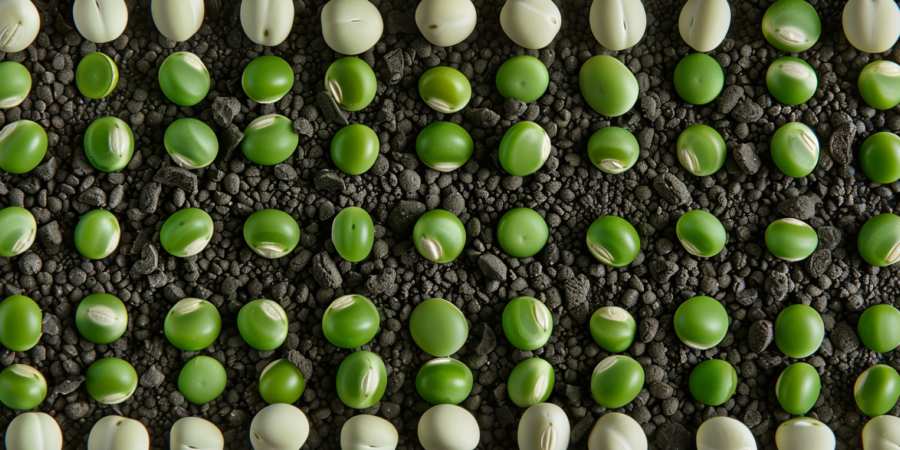The Gospel According to Legumes
A child presented with a sheet of sums will, unless freakishly precocious or bribed with chocolate, approach it like a tax return. But give that same child a bucket of fresh pea pods, the job of shelling them, and a quietly menacing adult in charge, and you have the beginnings of a mathematical revival. Every pod a mini-mystery, every pea a clue.Peas come in odd numbers. And then suddenly even. Children begin to notice patterns not because they’ve been told to, but because they’re right there in their hands. Seven peas in one pod. Four in the next. Ten in the third, and was that one split in half? Why does the average seem to hover around six? Now we’re estimating. Now we’re grouping. Now we’re collecting data without once mentioning the words “data collection.”
Estimation by Vegetable
Try estimating how many peas there are in a kilo. Better yet, try it after shelling half a basket. Fingers slippery, knees muddy, brain half-tuned to the robin hopping nearby, and yet—somehow—the child finds themselves working out probabilities, making guesses refined by experience.This is mathematics not as abstraction, but as direct engagement. Sensory, noisy, occasionally insect-adjacent. Numbers cease to be floating glyphs and become practical tools—used to predict the size of dinner, no less.
And lest anyone accuse gardening of being all earthy Zen and no rigour, consider that peas are countable, measurable, divisible, and arrive in natural, observable distributions. The curriculum practically writes itself, though you’ll still be told off for not using Comic Sans on your learning objectives.
Multiplication in the Soil
There’s nothing abstract about planting 20 seeds and watching only 12 come up. Here is a working model of probability, failure rates, and seasonal cruelty. You wanted a lesson in percentages? You’ve just had one. A dead sprout is not just a disappointment—it’s a subtraction problem.Then, when the survivors mature, they do so extravagantly. A single plant produces multiple pods. A pod contains multiple peas. And before long, the children are multiplying again, this time with sticky fingers and a newfound respect for agricultural yield. The word “harvest” no longer belongs to some ancient textbook about Mesopotamia. It’s what happened yesterday, in your hands.
Patterns, Predictably Found
If you want to teach patterns, go no further than the rows of beans and peas climbing their poles in silent, leafy ambition. Growth follows rules. Tendrils follow supports. Leaves unfurl in sequences. Fibonacci would have been thrilled, had he not been dead and possibly allergic to legumes.Ask a child to count the spirals in a sunflower head and you might get mild insurrection. Ask them to spot which of the pea plants grew fastest and guess why, and suddenly you have budding statisticians with dirty fingernails. They’ll track progress, notice trends, and—in some cases—stage mini-experiments involving water levels and possibly unauthorized urine samples.
Reckoning Without Worksheets
The key advantage of vegetable-based mathematics lies in its refusal to be ignored. A worksheet can be neglected. A worksheet doesn’t wilt. But a pea plant left unattended will make its displeasure known with a sort of vegetal petulance. Leaves droop. Aphids arrive. And suddenly, there’s an impromptu maths lesson about growth rate decline due to biological sabotage.Even the act of weeding becomes mathematical. Which bed had fewer weeds this week? Why? How many minutes did it take last week versus this one? These aren’t word problems; they’re life problems, which is more or less what word problems were trying to be before they fell into the hands of bureaucrats.
The Great Division
Perhaps the most contentious moment in any school garden arises when it’s time to divide the spoils. A bowl of peas, a hungry class, and the immutable rules of fairness. Suddenly, fractions aren’t abstract—they’re vital.Half a cup per student, unless Jamie’s absent, in which case everyone gets slightly more. But what if you save some for the cooking lesson tomorrow? Now we’re dealing with remainders. Some will argue that remainders should be eaten immediately, others that they should be frozen. Democracy flounders. Mathematical integrity is tested. Life, in short, continues.
- “If we have 17 students and 51 pods, how many pods per student?”
- “Each pod has an average of 6 peas—estimate total peas.”
- “Who shelled the most? Who claims they did and should be fact-checked?”
Beyond the Pea
Carrots offer lessons in length, weight, and disappointment. Potatoes are an exercise in mass and unexpected volume. And courgettes—those sneaky green interlopers—double in size seemingly overnight, offering practical insight into exponential growth and the risk of procrastination.Gardening not only teaches how to measure—it teaches when to measure. Wait too long and you miss the moment. Harvest too early and you learn about underestimation. Or flavourlessness.
The Root of the Matter
None of this is to suggest that formal education should be entirely replaced by legumes. That way lies anarchy—and possibly scurvy. But it does beg a question: why do we insist that learning must always be sedentary, clean, and laminated?Gardening brings risk, and reward. It brings errors you can eat, mistakes you can compost, and victories you can sauté. Numbers are not just learned, they’re lived. The process is messy, unavoidably honest, and—crucially—memorable. There’s no textbook in the world that will lodge itself in a child’s brain the way a worm in a radish will.
Peas of Pi
Mathematics in the garden doesn’t require a whiteboard, just curiosity and some seeds. It invites the learner to count not because they must, but because they need to know if they’ve got enough for lunch. In doing so, it performs an educational sleight-of-hand: it makes maths real.So next time someone suggests yet another set of worksheets to reinforce the concept of “grouping by fives,” hand them a basket of pods. Ask them to count by shelling. Ask them to group by handfuls. And then smile quietly as they begin to realise that numbers—when wrapped in chlorophyll and held in a child’s palm—don’t just add up.
They grow.
Article kindly provided by claymorelock-safe.co.uk



